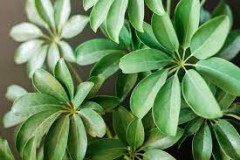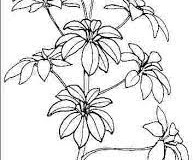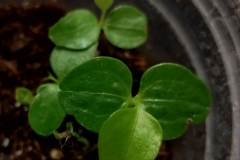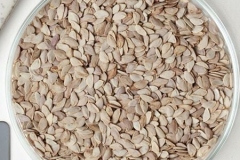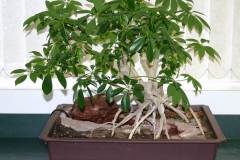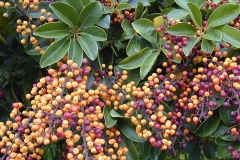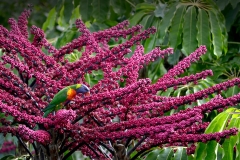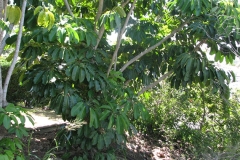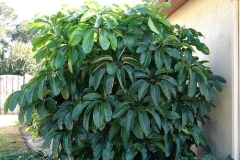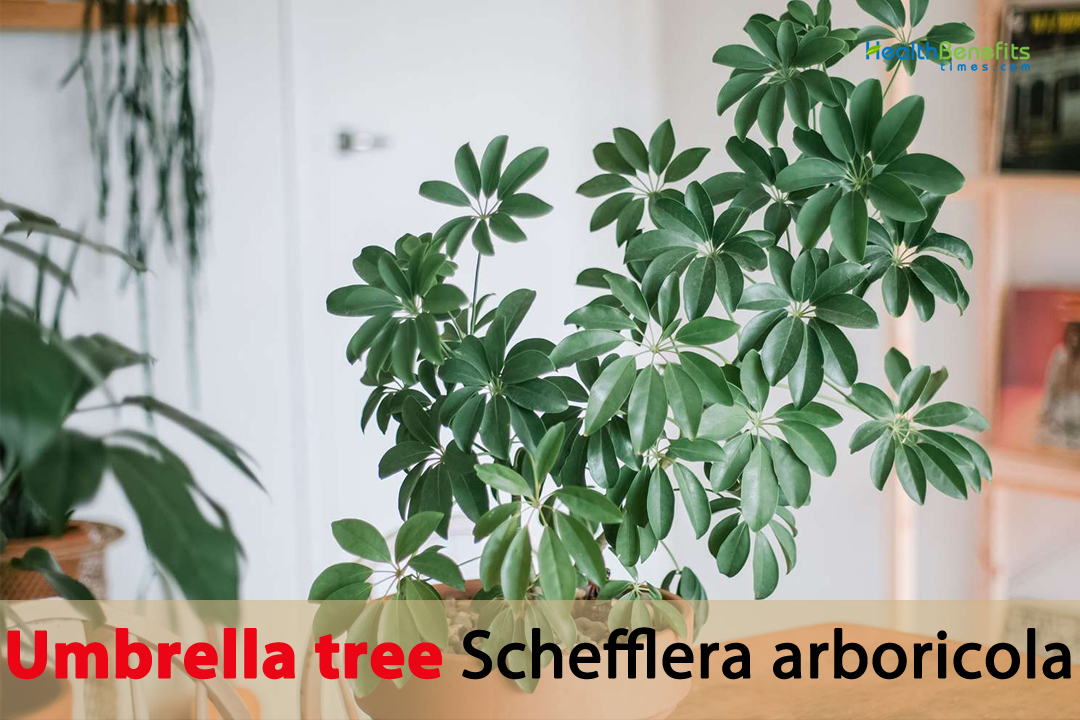 The umbrella tree, whose formal name is Schefflera arboricola, is a bushy, compact plant in the ginseng family (Araliaceae Juss.). The plant comes from places in Southeast Asia like Taiwan, southern China, and Malaysia. It can also be found in New Guinea and other parts of the South Pacific. It can now be found in parts of Queensland in the northern, tropical parts of Australia. These plants are also known as the Australian ivy palm, the parasol plant, the Dwarf umbrella tree, the Umbrella plant, the Chinese evergreen, the Trinette, the Gold Capella, the Amate, the Miniature umbrella tree, the Hawaiian elf umbrella, the Four-finger tree, the Octopus tree, the Finger tree, the Amate tree, and the Arboricola.
The umbrella tree, whose formal name is Schefflera arboricola, is a bushy, compact plant in the ginseng family (Araliaceae Juss.). The plant comes from places in Southeast Asia like Taiwan, southern China, and Malaysia. It can also be found in New Guinea and other parts of the South Pacific. It can now be found in parts of Queensland in the northern, tropical parts of Australia. These plants are also known as the Australian ivy palm, the parasol plant, the Dwarf umbrella tree, the Umbrella plant, the Chinese evergreen, the Trinette, the Gold Capella, the Amate, the Miniature umbrella tree, the Hawaiian elf umbrella, the Four-finger tree, the Octopus tree, the Finger tree, the Amate tree, and the Arboricola.
The genus name “Schefflera” comes from the name of a German scientist and botanist who worked in the 18th century and made important advances to the field of botany. “Arboricola” comes from the Latin words “arbour,” which means “tree,” and “cola,” which means “inhabitant” or “dweller.” The word “arboricola” means “tree-dwelling” or “inhabitant of trees,” which is a good way to describe this plant since it usually grows as a small tree or bush. The shiny, dark green leaflets on each leaf stalk spread outward in the shape of an umbrella, which is how it got its popular name, “Umbrella Tree.” Some types may have leaves that are speckled with white or yellow spots.
Umbrella Tree Facts
| Name | Umbrella tree |
|---|---|
| Scientific Name | Schefflera arboricola |
| Native | Southeast Asia, such as Taiwan, southern China, and Malaysia. It is also found in parts of the South Pacific, including New Guinea. Nowadays it is now found in the northern, tropical regions of Australia; in areas of Queensland |
| Common Names | Dwarf umbrella tree, Queensland umbrella tree, Umbrella plant, Australian ivy palm, Parasol plant, Starleaf, Australian umbrella tree, Chinese evergreen, Trinette, Gold Capella, Amate, Miniature umbrella tree, Hawaiian elf umbrella, Four-finger tree, Starleaf umbrella, Octopus tree, Dwarf schefflera, Finger tree, Amate tree, Arboricola |
| Name in Other Languages | Afrikaans: Sambreelboom Arabic: Shajarat al-Mazalah (شجرة المظلة) Bengali: Chhata gach (ছাতা গাছ) Bulgarian: Dŭzhdobranovo dŭrvo (Дъждобраново дърво) Chinese: Hè wàng lán (鹤望兰), E zhang chai, E zhang teng (鹅掌藤 ), Qī yè lián (七叶莲), Gǒu jiǎo tí (狗腳蹄), É zhǎng téng (鵝掌藤), É zhǎng bò (鵝掌蘗) Croatian: Kišobran drvo Czech: Deštníková rostlina, šeflera Danish: Paraplyplante Dutch: Schifflera or Parapluplant English: Dwarf umbrella-tree, Hawaiian-elf, Miniature schefflera, Parasol-plant, Dwarf schefflera, umbrella tree Estonian: Vihmavarju puu, võra-sõrmlehik Filipino: Punong-payong, Parasol, Arbre ombelle Arbre-parapluie Finnish: Sateenvarjo-puu French: Arbre ombrelle, parasol German: Strahlenaralie, Schirmaralie, Kleine Strahlenaralie Greek: Déntrο ompréla (Δέντρο ομπρέλα), Déntro tis omprélas (Δέντρο της ομπρέλας) Gujarati: Chhato vrksh (છાતો વૃક્ષ) Hebrew: Etz matria (עץ מטריה), Etz hamatra (עץ המטרה) Hindi: Chhata ped (छाता पेड़) Hungarian: Napernyőfa Icelandic: Regnhlíf Indonesian: Pohon payung, Walisongo Daun Kecil Italian: Albero ombrello Japanese: Shefurela (シェフレラ), Yadori fuka no ki, honkonkapokku (ホンコンカポック), shefurera, yadorifukanoki (ヤドリフカノキ) Kannada: Chata mara (ಚಾಟಾ ಮರ) Korean: Sweplela (쉐플레라), Usan namu (우산나무), hongkong-yaja (홍콩야자) Latvian: Lietus lupatnes koks Lithuanian: Lietpaltis medis Malay: Pokok payung Malayalam: Chathakam (ഛാതകം), Mazhapponnāli (മഴപ്പൊന്നാലി), kullan kudamaram (കുള്ളൻ കുടമരം) Marathi: Chhatrivruksha (छत्रीवृक्ष), Chhāyācī jhāḍa (छायाची झाड) Norwegian: Paraplytre Persian: Derakht-e Chatr (درخت چتر) Polish: Drzewo parasolowe, Szeflera drzewkowata Portuguese: Árvore-guarda-chuva Punjabi: Chhambde da rukh (ਛਾਂਬਦੇ ਦਾ ਰੁੱਖ), Chhāt darakkar (ਛਾਤ ਦਰੱਕੜ) Romanian: Copacul umbrella, Arbore Umbrelă Russian: Shefflera drevoobraznaya (Шеффлера древовидная) Serbian: Kišobran drvo Slovak: Dáždnikovník stromovitý Slovenian: Dežnik drevo Spanish: Árbol paraguas, Árbol de sombrilla Swahili: Mti wa mvua Swedish: Parasollväxt, Skuggväxt, Skuggrönn, Paraplyaralia Tamil: Muṭṭāḷi maram (முட்டாளி மரம்) Telugu: Cāvāḷamu (చావాళము), Ton rom Chonburi (ต้นร่มชลบุรี) Thai: Ton rom (ต้นร่ม) Turkish: Şemsiye ağacı Ukrainian: Derevo parasolya (Дерево парасоля) Urdu: Chhaye ki khachak (چھائی کی کھچک), Chha’o darakht (چھاؤ درخت) Vietnamese: Cây dù, Cây ô dù Zulu: Isihlahla soshobho |
| Plant Growth Habit | Fast-growing, compact and bushy, evergreen tree |
| Growing Climates | Along stream banks, wet forests, low woods, shaded borders, wet marshes and damp open woods |
| Soil | Use potting mix that drains well and has organic matter in it |
| Plant Size |
|
| Root | Has a network of fine, slender roots that emerge from the base of the stem and spread out in various directions |
| Stem | Slender and relatively flexible, especially in younger plants. As the plant matures, it may become slightly thicker |
| Bark | Bark is generally smoother and may have a somewhat glossy or shiny appearance while young turning to slightly rougher in texture as it matures |
| Leaf | Leaves are palmately compound, with 7–9 leaflets, the leaflets 9–20 cm long and 4–10 cm broad (though often smaller in cultivation) with a wedge-shaped base, entire margin, and an obtuse or acute apex, sometimes emarginate. The leaves are leathery in texture, shiny green, glabrous on the upper surface and somewhat lighter and matte on the underside |
| Flower | Hermaphroditic, having a colour ranging from yellow to green and a double perianth radial symmetry. They are composed of an entire annular calyx, five almost fully developed sepals, a corolla with five petals 2.5 mm long, with five stamens and five or six carpels that enclose the ovary. The style is not recognizable and the stigma is established |
| Fruit Shape & Size | Small and spherical drupe, with a diameter of about 1/4 to 1/2 inch (0.6 to 1.3 centimeters). They resemble tiny berries or drupes |
| Fruit Color | Initially green gradually ripen to a shade of red or orange as they mature |
| Fruit Skin | Thin and smooth, giving it a somewhat glossy appearance |
| Seed | Pale brown, oval like, 4 mm wide, 10 mm long |
| Flavor/Aroma | Pleasant green, earthy scent |
| Taste | Bitter, Acrid |
| Plant Parts Used | Root |
| Propagation | By seeds, Stem Cuttings, Air Layering, Division, Offsets, Leaf Cuttings, Root Cuttings, Layering, Tissue Culture |
| Lifespan | 5 to 20 years or more |
| Varieties |
|
| Health benefits |
|
Plant Description
The umbrella tree is an evergreen tree that grows quickly and is compact and bushy. It is usually about 4 to 8 feet (1.2 to 2.4 meters) tall when grown indoors and 10 to 25 feet (3 to 7.6 meters) or more when grown outdoors. The plant grows next to streams, in wet forests, in low woods, along shaded edges, in wet swamps, and in damp open woods. For indoor plants, use potting mix that drains well and has organic matter in it. It can grow in different types of dirt outside as long as it drains well. People in the area sometimes gather the plant in the wild to use as medicine. The plant is also sometimes grown as a hedge and is often grown as a decorative plant, both outside and inside. It is mostly grown as a houseplant for decoration and isn’t usually used in cooking. In fact, many parts of the Umbrella tree are poisonous if people or animals eat them, like the leaves and roots. Because of this, the Umbrella tree shouldn’t be used for cooking or other culinary uses.
Appropriate growing environment for Umbrella tree
To provide an appropriate growing environment for an Umbrella Tree, you should aim to replicate its natural habitat as closely as possible. Here are some key factors to consider:
- Light: When grown indoors, umbrella trees do best with bright, indirect light. Its leaves can get burned if you put it in full sunlight. If you’re growing it outside, pick a spot where the sun is blocked or spread out. It can handle some morning or late afternoon sun in mild areas.
- Temperature: For best results, keep the temperature inside between 65°F and 80°F (18°C and 27°C). Do not let cold drafts or temperatures below 50°F (10°C) hit the plant. In the outdoors, the umbrella tree does well in USDA hardiness zones 10 through 11. It can’t stand frost, so make sure the temperature stays above freezing.
- Humidity: This plant does best when the humidity is mild to high. If your home’s air is dry, you could use a humidity tray, a fan, or mist the plant often to add moisture.
- Watering: Don’t give your Umbrella Tree too much water. After you water, let the top inch (2.5 cm) of dirt dry out. Root rot can happen if you water too much, so make sure the soil drains well. Fill up the saucer under the pot with water and then empty it.
- Soil: For indoor plants, use potting mix that drains well and has organic matter in it. It can grow in different types of dirt outside as long as it drains well.
- Pot Size: If the roots of your Schefflera get too crowded, you should repot it every two to three years. Pick a pot that is a little bigger so that it can grow.
- Fertilizing: In the spring and summer, every 4 to 6 weeks, give your Umbrella Tree balanced liquid manure. During the fall and winter, fertilize less or not at all.
- Pruning: Cut back the plant to keep it in the shape and size you want. You can cut back taller plants or get rid of leaves that are dying or turning yellow.
- Pests and Diseases: Keep an eye out for spider mites, mealy bugs, and scale insects, which are all popular weed eaters. Take care of any pests right away. To avoid fungus diseases, make sure there is good air flow.
- Support: Putting stakes in your Umbrella Tree will keep it from falling over if it gets too tall and heavy at the top.
Roots
The umbrella tree usually has a fibrous root system, which means it has a web of thin, fine roots that grow from the base of the stem and go in different directions. This kind of root system works well to hold the plant in place and take in water and nutrients from the dirt. Most of the time, the roots are light to dark brown and feel like wood or fibers. These roots are designed to go deep into the ground and hold the plant in place. The roots’ depth can change based on how old the plant is, the size of the pot, or where it is planted. Because they are usually grown in pots, indoor umbrella trees have roots that aren’t very deep. When plants are outside, their roots may go deeper into the ground. The roots hold the plant firmly in place in the dirt, making it stable. They take water and important nutrients from the dirt and send them to other parts of the plant.
Stem
People often call the Umbrella tree’s main stem “the trunk,” even though it’s not as thick and hard as the trunks of big trees that grow outside. Instead, especially in younger plants, it is more likely to be thin and bendy. As the plant grows older, the stem might get a little thicker, but it still looks pretty thin. The umbrella tree is known for the way its branches are arranged in a way that looks like the spokes of an umbrella. Multiple side branches grow from the main stem and spread out in a whorled or umbrella-like pattern. These stems can be pretty long and thin, and they may have more than one leaf on them. Depending on the type and how it is grown, the tree can grow to different heights and in different ways. Indoor umbrella trees are usually smaller and more compact, so they can be used as houseplants. Outdoor types, on the other hand, may get taller and look more like trees as they grow.
Bark
The bark of smaller umbrella trees is usually smoother and may look a little glossy or shiny. It might be light to medium brown in color and feel pretty soft to the touch. As the plant grows older, the bark might get a little rougher. Different kinds and types of umbrella trees can have bark that is a different color. Most of the time, it’s between light and medium dark, but the exact color can change. Some types may have slightly grey or brown tones. The bark doesn’t usually have clear designs or markings on it like the bark of some tree species does. Instead, it tends to look more uniform, with only small differences in color and structure. Especially on smaller plants, the bark isn’t very thick. It doesn’t get the rough, thick bark those most big trees outside do.
The bark of the tree may change as it gets older. The skin might get a little rougher, and small cracks or creases might show up. On the other hand, its bark doesn’t usually get the deep furrows or noticeable ridges that you see on the bark of some larger tree types. Sometimes, the bark on older Umbrella trees is stronger and a little rougher than the bark on younger trees. The species, variety, and growing factors can all have an effect on this. The wood on indoor umbrella trees is usually smoother and thinner because they are grown as houseplants and are smaller. Outdoor types, on the other hand, may have more changes in the look and feel of their bark as they get older.
Leaves
These are compound leaves, which mean they are made up of many smaller leaflets that are grouped along a central stem, also called a petiole. There are usually between 7 and 16 leaflets on each leaf, but the exact number can change based on the species and variety. Leaflets are often lance-shaped or ovate, which means they are long and have a pointy or smooth tip. The shape can be a little different between species and varieties, but this is where it usually goes. The leaves’ sizes can change based on how old the plant is and how it’s growing. They are usually about average size, with leaves that are fully grown being about 2 to 4 inches (5 to 10 centimetres) long. The sides of the leaflets are usually smooth, with no teeth or serrations. This helps make the leaves look more delicate and graceful as a whole.
It looks like the leaves are a little shiny because their surface is smooth and glossy. The feel is mostly leathery and strong. There are different kinds and varieties that can have different coloured leaflets. Different shades of green, from light green to dark green, are common colors. Some types of plants may have leaves that are speckled with lighter or darker green spots or lines. The leaflets have big veins that run straight to the midrib, which is the leaflet’s main vein. The venation is usually raised on the leaflet’s upper side, giving it a rough look. Each leaflet has a thin stalk that connects it to the main stem, or rachis. The petioles on the leaves let them bend and adapt to changes in air and light flow.
It depends on the species and type of umbrella tree that the leaves are arranged in a pinnate or palmate way. The leaflets are lined up along a center axis in the pinnate arrangement, which looks like the structure of a feather. In this type of design, the leaflets spread out from a central point, making it look like a hand’s fingers. Along the rachis (central stem), the leaflets are connected one after the other. In other words, they are not straight across from each other on the stem; instead, they are spaced out. When they first come out, the youngest leaves are often a lighter, brighter green. As they get older, they get darker. These different leaf colors can make an attractive difference in the foliage.
Flower
The flowers are grouped in an inflorescence, which is a group of flowers. Depending on the species, the flower head is usually a panicle or raceme. The flower head may hang down in some species, but it may stand straight in others. Most flowers are small and not very showy. Most of the time, they are greenish-white to yellowish-green in color. Each flower is made up of five small blooms and is usually less than half an inch (1 centimetre) across. Each flower has five petals, some of which may be slightly joined together at the base. The flowers are usually long and narrow, and they look like tubes or bells. The flowers have radial symmetry, which means they are actinomorphic. Most flowers have radial symmetry.
The flowers of an umbrella tree are usually dioecious, which means that each plant has either male or female flowers. The male reproductive organs of flowers are called stamens, and they make pollen. The female reproductive organs of flowers are called pistils, and they hold the ovules. It’s not known that umbrella tree flowers have a strong or noticeable scent. The leaves, not the flowers, are what make them so appealing. Trees get pollinated by bugs like bees and flies in their natural environment. They may not make seeds when growing indoors, though, and they don’t depend on bees to pollinate them.
Fruits
Most umbrella tree fruits are small and round, measuring about 1/4 to 1/2 inch (0.6 to 1.3 centimetres) across. They look like little drupes or berries. Different kinds and varieties of fruits have different colors, but most of the time they are green when they first grow and turn red or orange as they get older. The fruit looks kind of shiny because its skin is thin and smooth. Most of the time, it doesn’t have any visible fuzz or hairs on it. Some plant types make fruits that birds and other animals eat, but they are usually not meant to be eaten by people. Interestingly, people don’t usually eat the fruits; they’re grown for their looks rather than as a food source.
Seeds
It looks like a bean, but the umbrella tree seeds are small and oval. Different kinds and varieties of seeds can be a little different size, but most are less than 1/4 inch (0.6 centimetres) long. Umbrella tree seeds can be any color, but most of the time they are brown, black, or a color that looks like dirt. The exact shade may rely on things like the species and how mature the seeds are. There is a seed coat around each seed, which is the top protective layer. There are times when the seed coat is very thin and smooth. When the seed sprouts, it usually makes one or two cotyledons, which are seed leaves. These cotyledons are the first leaves to grow from the seed. They feed the young seedling until the real leaves grow.
Varieties of Umbrella tree
The Umbrella tree has several varieties and cultivars that offer a range of sizes, leaf colors, and growth habits. Here are some popular varieties of the Umbrella tree:
- Schefflera arboricola ‘Amate’: This type has bushier growth and leaves that are bigger and shinier green. It is popular for gardening both inside and outside because of its lush leaves.
- Schefflera arboricola ‘Gold Capella’: The centers of the leaves on this variety are bright green, and the edges are yellow to gold. It makes a big difference between indoor and outdoor settings.
- Schefflera arboricola ‘Trinette’: The leaves of ‘Trinette’ are known for having different coloured edges that range from creamy white to pinkish. The centers of the leaves are green. It’s a nice-looking choice for decorating inside.
- Schefflera arboricola ‘Janine’: The leaves on this type are smaller than those on the standard Schefflera arboricola, which makes it an easier to care for houseplant.
- Schefflera arboricola ‘Luseane’: The cultivar “Luseane” is known for its beautiful leaves with deep serrations. It looks different from other types in a very noticeable way.
- Schefflera arboricola ‘Tricolor’: People love this type because its leaves are three colors: green in the middle, creamy white around the edges, and pink or red spots on them. It’s a beautiful way to add color to inside areas.
- Schefflera arboricola ‘Nora’: The “Nora” variety has small, closely-spaced leaves and a tight growth habit. This is a great option for small rooms or displays that sit on a table.
- Schefflera arboricola ‘Victoria’: There are white and green designs on the leaves of this cultivar, which makes them look beautiful indoors.
- Schefflera arboricola ‘Compacta’: This type grows more closely together and has smaller leaves, as the name suggests. It can be used in small spaces or as a plant on a table.
- Schefflera arboricola ‘Bonsai’: This type is often grown as a bonsai tree, which looks like a small Umbrella tree with neatly cut branches and leaves.
Health benefits of Umbrella tree
Umbrella tree is primarily grown as an ornamental houseplant. While it is not typically used for medicinal purposes, it does offer several indirect health benefits when kept as an indoor plant:
1. Improved Air Quality
Like many other indoor plants, the umbrella tree can help clean the air by removing pollution like formaldehyde, benzene, and toluene. This may improve the health of your lungs and make symptoms like allergies and congestion go away.
2. Mood Enhancement
Many people feel better when they are around umbrella trees, especially when they are inside. It’s beautiful, bright green leaves and flowing shape can make a space look nice and calm, which may help people who are stressed or anxious.
3. Stress Reduction
Take care of house plants like the umbrella tree. It can be therapeutic and calming to do so. This can help people feel less stressed, lower their blood pressure, feel relaxed, and feel like they’ve accomplished something.
4. Aesthetic Value
People like umbrella trees because they look nice and have lush, green leaves. It can make indoor spaces look better, which can have a good effect on mood and overall atmosphere.
5. Connection to Nature
A lot of people like umbrella trees because they look good and have lots of green leaves. It can make places inside look better, which can be good for your mood and the setting as a whole.
6. Cognitive Benefits
Studies have shown that house plants like the umbrella tree can help your brain work better. Plants that boost oxygen levels can make people more alert help them focus, and make them more productive.
7. Biophilic Benefits
The idea of biophilia is that people are naturally connected to nature. This biophilic need can be met by having an umbrella tree, which may lower stress and improve your sense of well-being.
8. Sleep Quality
The better air quality that comes with having an umbrella tree can help you sleep better. To get a better night’s sleep, people with allergies and irritations can sleep better at night when the air is clean.
9. Enhanced Mental Well-being
Having an umbrella tree inside can help you feel calm and healthy. Studies have shown that spending time with indoor plants can help improve mental health and lessen the effects of sadness.
10. Natural Humidifier
The process by which umbrella trees release water into the air is called evaporation. This can naturally add moisture to the air. This is especially helpful in dry indoor settings, as it helps with problems like skin that feels tight and breathing problems.
11. Allergy Symptom Reduction
Evaporation is the process by which umbrella trees lose water into the air. This can easily make the air moister. This is especially helpful when you’re inside and the air is dry. It helps with skin that feels tight and breathing issues.
12. Enhanced Productivity
The water in umbrella trees is lost into the air through evaporation. The air will likely get damper because of this. When you’re inside and the air is dry, this is very helpful. It helps when your skin feels tight and when you have trouble breathing.
13. Holistic Well-being
The water in umbrella trees evaporates into the air. This is likely to make the air damper. This is very helpful when you’re inside and the air is dry. It makes your face feel better and helps you breathe better when you can’t.
14. Purification of Volatile Organic Compounds (VOCs)
It’s possible for umbrella trees to lose water to the air. The air will probably get wetter because of this. When you’re inside and the air is dry, this is very helpful. It feels better on your face and helps you breathe better when you can’t.
15. Emotional Support
Taking care of indoor plants, like an umbrella tree, can help you feel better and give you a sense of company. Taking care of a living thing can give you a sense of meaning and connection.
Different uses of Umbrella tree
The Umbrella tree is primarily grown as an ornamental houseplant due to its attractive appearance and ability to improve indoor air quality. Its uses are primarily decorative and environmental. Here are the different uses of the Umbrella tree:
- Indoor Decoration: A lot of people like to decorate their homes with umbrella trees. It looks nice in homes, businesses, and other indoor places because of its lush green leaves and graceful growth pattern.
- Air Purification: Like many other indoor plants, the umbrella tree can help clean the air by soaking up pollution like formaldehyde, benzene, and xylene. Because it can clean the air, this makes it a useful addition to inner spaces.
- Stress Reduction: Tending to houseplants, like the Umbrella tree, can be a soothing and stress-relieving exercise. The act of taking care of the plant and seeing it grow can make you feel calm and happy.
- Aesthetic Enhancement: People like the Umbrella tree because it looks nice. On the whole, it can improve the look and feel of indoor areas, making them more pleasant and appealing.
- Biophilic Design: Biophilic design concepts say that people are naturally connected to nature. Adding plants like the umbrella tree to indoor areas can meet this biophilic need, which may lead to better health and mood.
- Educational Tool: People who teach and parents can use the umbrella tree as a teaching tool. It’s a chance to teach kids and teens about biology, taking care of plants, and being responsible for the world.
- Environmental Benefits: Better air quality and humidity levels inside thanks to the umbrella tree make the indoor environment better, which indirectly improves respiratory health and general health.
- Privacy Screen: Larger varieties of the umbrella tree can be planted outside in some landscaping settings to make a natural privacy screen. The thick foliage of these plants can block out unwanted views of your house.
- Shade Provider: Mature umbrella trees can provide shade outside, which makes them a good choice for parks, patios, or places to sit outside. Their big leaves can protect you from the sun’s harsh rays.
- Potted Patio Plant: Mature umbrella trees can provide shade outside, which makes them a good choice for parks, patios, or places to sit outside. Their big leaves can protect you from the sun’s harsh rays.
- Office and Commercial Spaces: People often choose the umbrella tree for offices, shopping malls, and other commercial spaces to make the atmosphere better and make the area look better.
- Airbnb and Rental Properties: People often choose umbrella trees for businesses, shopping malls, and other public places to improve the look and feel of the area.
- Therapeutic Horticulture: People who are going through therapy or recovery may find it helpful to garden and take care of plants like the umbrella tree. It gives people with physical or mental health problems something fun and good to do.
- Natural Photography Background: Because its leaves are so pretty and even, photographers often use the Umbrella tree’s lush foliage as a background for picture and nature photos.
- Gift and Decorative Plant: In many cases, like housewarming parties, weddings, and holidays, people choose the umbrella tree as a gift plant. It’s a nice gift because it’s beautiful and cleans the air.
- Botanical Interest: Botanists and plant lovers can grow the Umbrella tree to learn more about how it grows, how its leaves change, and how it can survive in different habitats.
- Natural Habitat: Some types of umbrella tree help the ecosystem where they live by giving animals a place to live and shelter in places like Australia and parts of the South Pacific.
- Craft and Floral Arrangements: Umbrella tree stems and leaves that have been cut off can be used to add a unique and exotic touch to crafts and flower arrangements.
Side effects of Umbrella tree
The Umbrella tree is primarily grown as an ornamental houseplant. While it is generally considered safe when handled appropriately, there are some potential side effects and precautions to be aware of:
- Toxicity: People and animals should not eat certain parts of the Umbrella tree, especially the leaves, roots, and sap. If you eat even a small amount of these plant parts, you could get sick, throw up, have diarrhea, or get skin rash. The plant must be kept out of reach of kids and pets at all times.
- Allergic Reactions: Some people may be sensitive to or allergic to the plant’s sap or particles in the air. If you get the sap on your skin, it can irritate or even cause allergic eczema. If you have an allergic response, you might just get redness and itching, or you might get blisters and swelling. If your skin is irritated, wash it with soap and water and see a doctor if the symptoms don’t go away or get worse.
- Eye Irritation: The sap might make your eyes hurt. If sap gets in your eyes, wash them out well with clean water and see a doctor if the redness doesn’t go away.
- Pregnancy and Pets: People who are pregnant or who have pets should be careful around umbrella trees because they could be poisonous. If there are worries about exposure, it’s best to talk to a qualified medical worker or veterinarian.
- Digestive Issues in Pets: Pets can get sick if they eat any part of the umbrella tree. Animals like cats and dogs may show signs like drooling, puking, diarrhea, and stomach pain. If you think your cat has eaten any part of the plant, you should call your vet right away.
- Respiratory Irritation: As an air purifier, the umbrella tree can make indoor air better, but people with breathing problems or allergies may feel a little itchy or uncomfortable if they are exposed to airborne particles from the plant.
References:
https://www.itis.gov/servlet/SingleRpt/SingleRpt?search_topic=TSN&search_value=822326#null
http://www.hear.org/pier/species/schefflera_arboricola.htm
https://www.cabidigitallibrary.org/doi/10.1079/cabicompendium.48921
https://gd.eppo.int/taxon/SCHAR
http://www.theplantlist.org/tpl1.1/record/kew-187008
https://en.wikipedia.org/wiki/Heptapleurum_arboricola
https://indiabiodiversity.org/species/show/226231
http://germoplasma.iniaf.gob.bo/gringlobal/taxonomydetail.aspx?id=312974
https://tropical.theferns.info/viewtropical.php?id=Schefflera+arboricola
https://plants.usda.gov/home/plantProfile?symbol=SCAR10


